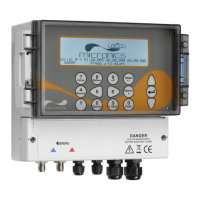6: Troubleshooting
48 U3000/U4000 User Manual
(Issue 2.0)
6.4 Diagnostics Display
This feature is designed for advanced users and is intended to provide information that will aid the user to
diagnose problems – e.g. no signal strength.
When operating in the FLOW READING mode you can access a diagnostics screen by pressing the Options
function key and then selecting Diagnostics from the FLOW READING OPTIONS screen. This will display
the operating values for the following parameters.
Calculated time (µs)
This is a value the instrument predicts will be the time in µsecs that it should take for the acoustic wave to
propagate across a particular pipe size. This value is ascertained from the data entered by the user. i.e. Pipe
size, material, sensor set etc.
Actual time (µs)
This is the value the instrument measures as the time taken for the acoustic wave to propagate across the
pipe. It is used to see if the signal is being taken from the burst, at the correct time to get the strongest signal.
This value is normally a few µs below the calculated µs value. If, however, this value is much greater than the
calculated time then there is a problem with the set-up.
Flow (m/s)
This displays flow velocity in m/sec to 3 decimal places.
Signal strength
This is the averaged value of Signal and should be a value between 800 and 1600 – where 800 is
approximately 50%, and 1600 is approximately 100%.
Gain
Gain values are typically in the range 600 to 850.
Switches
Typical Switches values are None and *10. On small pipes (and when using the test block) the value should
be None. A Switch value of *100 indicates poor sensor set-up or poor connections.
UP/DN time difference
The difference in transit times between the upstream and downstream signals due to the fluid flow.
Fluid propagation rate
This is the sound speed of the fluid calculated using the data entered by the user.
Sensor separation
The same value as displayed in the setup screen.

